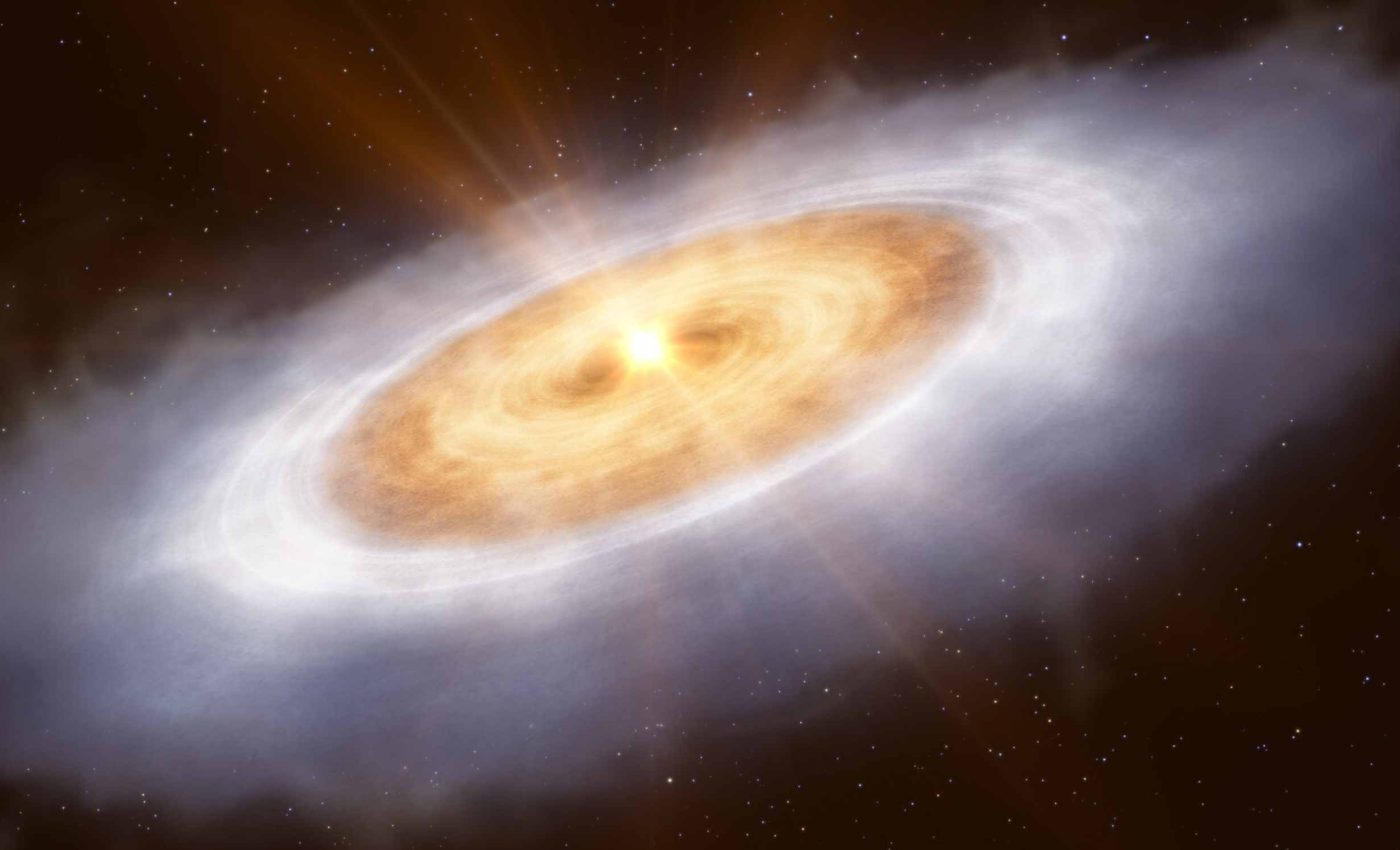
Heavy water found in a planetary disk confirms oceans can form before stars
Astronomers have spotted heavy water in the planet-forming disk around the young star V883 Orionis, about 1,300 light years away. The find shows that some water formed before the star was born. It likely survived the chaotic steps that build planets.
The signal comes from doubly deuterated water, a version of H2O that carries two heavy hydrogen atoms. It is the first time this specific molecule has been seen in a planet forming disk. That detail changes the timeline of how water moves from clouds to worlds.
Why heavy water, young stars
Heavy water is a precise tracer of cold chemistry. Doubly deuterated water, water with two hydrogen atoms replaced by deuterium, forms mainly at very low temperatures and resists re forming if destroyed.
The work was led by Margot Leemker, lead author and astronomer at the University of Milan. Her research focuses on how water chemistry records the earliest phases of star and planet formation.
V883 Orionis is in a high activity phase that warms its disk and pushes the water snow line far from the star. That change reveals the bulk water reservoir as vapor that radio telescopes can study.
Astronomers call the snow line, the distance from a star where water switches from ice to gas. Pushing that line outward lets instruments pick up faint water fingerprints that would otherwise hide in ice.
How the measurement works
The Atacama Large Millimeter or submillimeter Array (ALMA) sits high in Chile. It measures faint radio signals from molecules in space.
Its sensitivity helped separate a weak D2O feature from other signals in the disk. That precision matters when different species overlap in crowded spectra.
V883 Orionis offered a lucky setup. Its current outburst, by independent analysis, heats the inner disk, so more water becomes vapor that ALMA can detect cleanly.
ALMA sorts light into narrow channels and looks for telltale spikes from molecules. That pattern lets scientists pick out water species and compare their strengths.
A spectral line, a sharp feature at one frequency, marks a specific transition in a molecule. By measuring several lines together, teams can extract temperatures and relative abundances with fewer ambiguities.
In the new paper, the team reports a D2O to H2O ratio. It is about 3.2 times 10 to the minus 5. They also find that the D2O to HDO ratio scales about twice the HDO to H2O ratio. That pattern is expected if the water is largely inherited.
“We present strong evidence of inheritance,” said Margot Leemker, astronomer at the University of Milan. The numbers match values seen in proto stellar envelopes and at least one comet, which argues against wholesale chemical reset in the disk.
Missing link comes into view
Earlier work traced gas phase water in V883 Orionis and linked its composition to comets. That study closed a key gap between interstellar clouds, young disks, and the icy bodies that can deliver water to rocky planets.
“We conclude that disks directly inherit water from the star forming cloud,” wrote J. J. Tobin, lead author of the 2023 study. The new heavy water result strengthens that case by adding a colder born molecule to the chain.
The term isotopologue, a molecule that has the same formula but different isotopes, matters here. Water with more deuterium tends to form and survive under colder, shielded conditions in space.
Models show that a combined ratio offers a sharper test of heritage. As one research explains, compare D2O to HDO against HDO to H2O. That combined ratio better separates inherited ice from water rebuilt later.
Comets assemble from the same dusty ice grains that drift in young disks. If much of the water in those grains predates the star, some planetary oceans could track their origin.
That idea fits the heavy water pattern in V883 Orionis. It also helps explain why some comets carry deuterium levels that look like the early cloud environment rather than fresh chemistry near a star.
Checks against false positives
Teams test whether other molecules could mimic the same signal. They also model the lines to ensure the inferred ratios hold across a range of reasonable temperatures.
Uncertainties remain, but they are accounted for in the reported errors. More data at slightly different frequencies will tighten the bounds and stress test the inheritance picture.
Lessons from heavy water and stars
One detection is a start, not the finish line. Different stars may process water differently, depending on outbursts, radiation, and how much material falls inward.
Another test will be mapping heavy water across the disk, ring by ring. That pattern could reveal where icy grains drift, grow, and trap volatiles before planets assemble.
Finding D2O in one disk opens a path to compare systems at different ages and temperatures. Surveys can test whether inherited water is common or whether some stars wipe the slate and start over.
A broader map of heavy water, singly deuterated water, and regular water will sharpen that picture. It will also help researchers trace which disks are more likely to deliver water rich comets to young rocky planets.
The study is published in Nature Astronomy.
Image credits: ESO/L. Calçada.
—–
Like what you read? Subscribe to our newsletter for engaging articles, exclusive content, and the latest updates.
Check us out on EarthSnap, a free app brought to you by Eric Ralls and Earth.com.
—–













